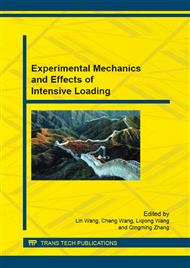p.271
p.278
p.291
p.296
p.302
p.311
p.316
p.326
p.335
Investigation of Mesh Dependency of Materials Fracture in the Finite Element Simulation of a Projectile Penetrating into a Target
Abstract:
In finite element numerical simulation, the calculating results of geometrical models with different mesh density tend to have obvious differences, especially when material damage and fracture are considered. In order to study the mesh dependency of the finite element calculation, models of a projectile penetrating into the target with different mesh densities are constructed by using LS-DYNA. A nonlocal approach is investigated and the results without and with MAT_NONLOCAL are compared. It is found that the nonlocal model with a variable characteristic length parameter provides a relatively accurate and stable result, and the calculation cost can be reduced.
Info:
Periodical:
Pages:
302-308
Citation:
Online since:
August 2015
Authors:
Keywords:
Price:
Сopyright:
© 2015 Trans Tech Publications Ltd. All Rights Reserved
Share:
Citation:


